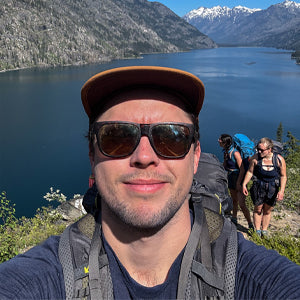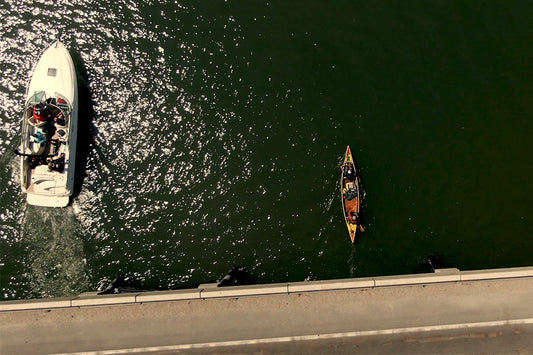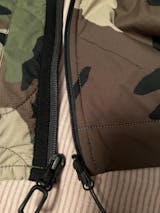JUMP TO:
INTRODUCTION
Ultra running is a steep, slippery slope (pun intended). The standard marathon distance might scratch the adventure itch one day, and then the next, running 100 consecutive miles seems like a completely normal and reasonable goal. I liken ultra running to the red pill metaphor—once you discover what the human body is capable of and just how deep the rabbit hole goes, it can be difficult to turn back.
As a newcomer to the sport, I wanted to see what the ultra running craze was all about. With a handful of marathons, endurance bike rides and an Ironman under my belt, the Wy’east Wonder—a 50-mile trail run through the woods of Mt. Hood, OR—felt like an appropriate challenge in which to surrender my summer. As such, I’ve spent the last eight months exploring the trails outside of Seattle, running well beyond my perceived capabilities and learning the dos and don’ts of trail running first hand.
Here’s how and why I did it.

( Photo credit: @fullsendmedia_ )
A NOTE ON RUNNING
Before I dig in, I want to highlight specifically what I like about trail running.First and foremost, running is a flow state trigger. To quote Mihaly Csikszentmihalyi’s Flow: The Psychology of the Optimal Experience, flow is “the state in which people are so involved in an activity that nothing else seems to matter; the experience itself is so enjoyable that people will do it even at great cost, for the sheer sake of doing it.” In layman’s terms, you’re locked in, feel pretty darn good and nothing else matters. This is my preferred method of meditation—flow is a brain-cleanse, an escape from the stressors of everyday life, an opportunity to turn off my brain while simultaneously checking in. I often feel mentally refreshed after a long day on the trail, despite being physically wiped. Long distance running, in my experience, is a flow state cheat code.
The benefits of flow are compounded by spending time in nature. I’m lucky to live in an outdoor recreation mecca, where I have access to some of the most scenic terrain the nation has to offer. Trail running gave me the key to venture farther than ever before, pushing the limits of a day trip far beyond that of a typical hike. Consistently exploring new territory, when coupled with flow, created a massive positive reinforcement loop that allowed me to look forward to my long runs.
Lastly, trail running is hard, and it’s supposed to be. I’ll spare you all the personal growth / self-improvement jargon, but I like running long distances for the sake of challenging myself. The more you do hard things, the easier it becomes to do hard things.
I mention these because running is notoriously easy to dismiss. Don’t listen to the non-believers, there’s plenty of Type 1 fun to be had.

TRAINING FOR A 50-MILE ULTRAMARATHON
I’m new to ultramarathons, but I’m no stranger to long days. Building upon the aerobic base I had built up for my April Orcas Island Trail Marathon (which required a training plan of its own), I wrote an 18-week training plan to officially kick off 50-mile training season. My training was broken into four primary blocks, with each block consisting of a three-week build followed by one deload week. My single longest outing was exactly three weeks from race day, signaling the start of a three-week taper. Here are some key stats from my training plan:- Longest Run: 32 miles
- Highest Weekly Volume: 62 miles
- Total Miles Logged: 763 miles
I experimented heavily with my gear throughout my training, ironing out the kinks long before I lined the start line. From apparel, shoes and vests to exploring the myriad of fuel and nutrition options, I wanted to dial in my kit and ensure there would be no surprises come race day. Admittedly, I wore one of three shirts for the bulk of my long runs:
- SolarSwift Short Sleeve Tech T— The gear heads at Beyond Clothing knocked this one out of the park. With laser-cut vents that promote airflow where you need it, the SolarSwift dries quickly and keeps you cool in the process, offering a durable yet lightweight shirt that became my go-to trail running shirt this season. For these reasons, the SolarSwift made the cut for my race day fit.
- FirstSun Short Sleeve Shirt — The hidden snap-button design allows for controllable breathability, which played to my advantage on warmer training runs. The collar helps avoid irritation around the neck from my running vest, and when combined with the UPF 50+ rating, the FirstSun made for an excellent all-around adventure shirt this summer.
- Geo-T Hoodie — As mentioned in my warm weather hiking piece, the Geo-T is a must-have when running in direct sunlight for extended durations. Its knit honeycomb design creates a breathable, moisture-wicking fabric that dries remarkably fast, which cooled me off while the UPF 50 sun protection shielded me from UV radiation.
My biggest takeaway from ultramarathon training is to take things slowly. After a few weeks of consistent running, you might have the cardio endurance to run incredible distances, but it takes much longer for your body to build the adaptations to keep up with your ambition. It’s best practice to build mileage gradually, temper expectations, and make adjustments to your training as necessary to avoid injury and stay on your feet.

( Photo credit: @fullsendmedia_ Mid race while wearing the SolarSwift Tech-T.)
RACE DAY
With the hay in the barn, the only thing left to do was run the damn thing. I set a 3:45 a.m. alarm to give me enough time to scarf down a hearty breakfast and get to the start line in time for an emergency bathroom break. I had a good gut feeling—I knew I had put in the work, now it was time to prove it.
( Photo credit: Strava )
The Wy’east Wonder is a point-to-point course with an added 20-mile loop near the mid-way point. There are six aid stations, one of which I passed through at mile 18 and again at mile 38. I was able to check in with family members at this aid station, which made for three distinct sections of this race. Compartmentalizing 50 miles into three digestible runs made a big day feel like a doable day.
It’s worth mentioning that I didn’t do this race alone—along with the support from my family, I was lucky to have a friend crazy enough to run this with me (in fact, she’s the one who nudged me to sign up in the first place). With the opportunity to chat and joke around, we reached mile 18 in high spirits and ahead of our goal pace. So far, so good. After refueling with my own food and a brief conversation with our support crew, we set off on the 20-mile loop.
My first low point was around mile 25. With half the race in the books, I was beginning to feel the day wear on me in the form of tight hip flexors. Still early in the race, I knew this feeling would eventually give way to a second wind, but suffice to say the pre-race jitters were long gone. I was no longer running with my friend at mile 33, heading solo into the inevitable pain cave.
Miles 33-37 marked my second low point. This section of the course was either uphill or flat—just enough to leapfrog between trotting and power hiking for a solid four miles. I’m certainly one to joke about how much I love the grind, and that I look forward to the struggle, and I had to remind myself of this notion during this stretch of the course. Quite literally, I had to walk the walk. Again, I wasn’t thinking about mile 50 just yet, instead looking forward to the morale boost waiting for me at mile 38 where I’d see my family again.
Upon reaching mile 38—and embarking on the final stretch of my three-part race—I began to face the reality that I’d still be racing after my watch clocked 50 miles. While watch GPS data is never going to be perfect, I had noticed that my watch’s mileage was out of sync with the official course markings by a significant margin. This came to a boil at the final aid station—I should have been at mile 45.3 with 4.9 miles to the finish. Instead, my watch marked 46.6. As comically difficult as it was to do mental math this late in the game, I realized that I’d have to hit at least 51.5 miles before crossing the finish line. In the moment, this was a soul-crushing realization.
To sweeten the deal, I reached a clearing at mile 50 that unveiled a series of steep, rocky switchbacks descending to the finish line. Even on fresh legs, I’m not sure there would be any running down this stony labyrinth, let alone on mile 50 legs. The final 2.5 miles of the Wy’east Wonder included a 2,000ft descent, a proper slap in the face when, according to my watch, I should have already cracked a celebratory beer.
At mile 52.1, I crossed the finish line in 11 hours and 30 minutes, averaging a 13:16 mile pace. Through eight months of dedicated training, dozens of mountain excursions and over 1,100 miles logged for the year, I can now say the following with confidence: 52 miles is definitely more than 50 miles.
 ( Crossing the finish line. )
|
 ( Crushing a celebratory beer. )
|








0 Comments